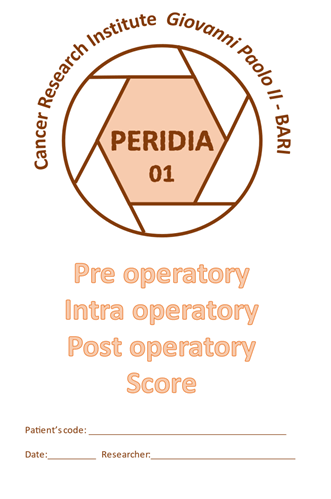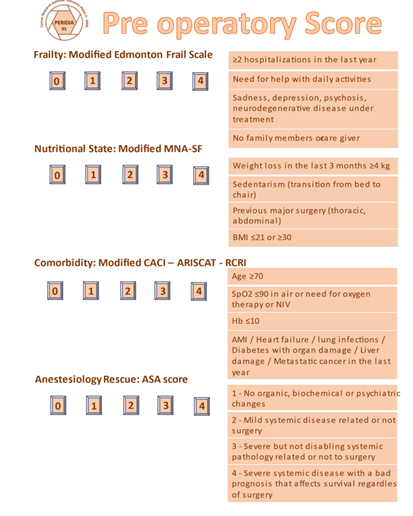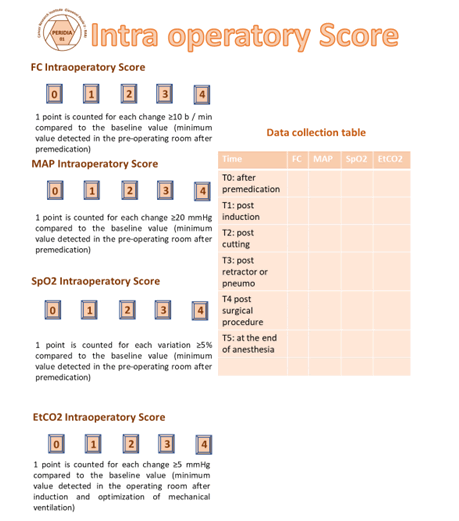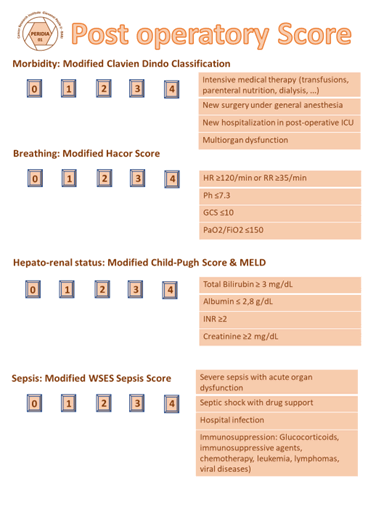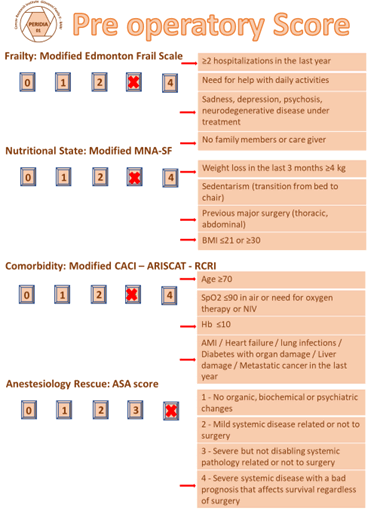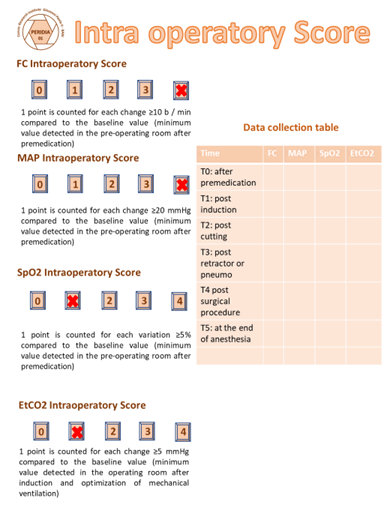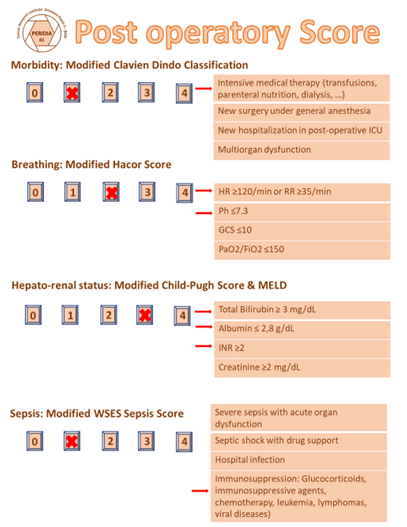Introduction
Nowadays the standardization of peri operatory assessments
in cancer patients undergoing per diaphragmaticthoracoabdominal
surgery is a very complex challenge, particularly in
the case of multi-organ localization. This aim is worldwide
pursued for each patient through the application of
international evaluation scores in the pre operatory step
(fragility, nutritional structure, comorbidities, previous thoracoabdominal
problems) and/or the prediction of the post
operatory onset of complications.
To our knowledge, only a few experiences are reported in
literature in terms of peri operatory evaluation, in particular the
intra operatory phase lacks shared and validated references as
regards clinical scores in critical patients, passing through the
three steps, pre, intra and post-surgery.
The following case report is a substantial example of the
PERIDIA Score retrospectively applied in our post-operative
cancer ICU in 2018 [1-5].
Materials and Methods
A multidisciplinary group, consisting in anesthesiologists,
abdominal cancer surgeons and thoracic cancersurgeons,
pharmacists, psychologists, statisticians, nurses, hasel borated
the PERIDIA Score (Figures 1-4), starting from the analysis of the
literature reference scores.
Figure 1: Pre operatory intra operatory-post operatory score.
Figure 2: The score allows to assign from 0 to 16 points in
each phase. The minimum score is 0; the maximum score is 48.
Figure 3: Intra operatory score.
Figure 4: Post operatory score modified Clavein Dindo
classification.
In the first step of our study, some scores already in use in
clinical practice were selected for the peri operatory evaluation
process. Edmonton Frail Scale, Mini Nutritional Assessment
Short Form, Charlson Age Morbidity Index, Assess Respiratory
Risk in Surgical Patients in Catalogna (ARISCAT Index), Lee’s
Revised Cardiac Risk Index, Preoperative Esophagectomy Risk,
Clavien dindo Classification, Child Pugh Score, Model for End
Stage Liver Disease, Simple Risk Score for Pancreatectomy
Surgical Outcomes Analysis and Research, Hacor Score and
World Society of Emergency Surgery Sepsis Score were deeply
analyzed and synthetized by the team to extract the most
significant items to build our new score, named PERIDIA score
[6-8].
The PERIDIA score has been subsequently divided into 3
scores, each of which expressing a score from 0 to 16 for a
maximum of 48 points. The first score concerns the pre
operatory period and supports the anesthetic and surgical
evaluations of pre-hospitalization. It consists in 4 scores, to each
of which a score from 0 to 4 points can be assigned. With regard
to the Modified Edmonton Frail Scale, a point is assigned to the
verification of each of the following conditions: ≥ 2
hospitalizations in the last year; need for help with daily
activities; sadness, depression, psychosis or neurodegenerative
disease in treatment; absence of family members or caregivers.
Regarding the Modified Mini Nutritional, Assessment Short
Form, a point is assigned to the verification of each of the
following conditions: weight loss in the last 3 months ≥ 4 Kg;
sedentarism (transition from bed to chair); previous major
surgery (thoracic, abdominal); BMI ≤ 21 or ≥ 30. About the
Modified Charlson Age Morbidity Index, ARISCAT Index and Lee's Revised cardiac Risk Index, one point is assigned for each of the
following conditions: age ≥ 70 years; SpO2 ≤ 90 inair
environment or need for oxygen therapy or non-invasive
ventilation; haemoglobinemia ≤ 10 g/dl; AMI or heart failure or
lung infections or diabetes with organ damage or liver injury or
metastatic solid tumor in the last year. Finally, the ASA score is
taken from the anesthetic assessment pre-hospitalization and in
any case is assigned on the basis of the following criteria: 1
points for no organic, biochemical or psychiatric alteration; 2
points for mild systemic disease related or not to the reason for
the surgery; 3 points for severe but not disabling systemic
pathology related or not to the reason for the surgery; 4 points
for severe systemic disease with a severe prognosis that affects
survival regardless of surgery [9,10].
For the intra operative period, the multidisciplinary technical
team aimed at matching the main phases of the surgery (T0:
Pre-treatment after pre-dressing; T1: Post induction; T2: Post
cutting; T3: Post retractor or pneumo; T4: Post surgery; T5: Post
anesthesia) with the variation of 4 vital parameters commonly
used during the monitoring of general anesthesia (heart rate or
HR, mean arterial pressure or MAP, saturation or SpO2,
capnometry or EtCO2) [11-15].
However, due to the lack of punctual clinical parameters in
intra operatory period, in the present case report, we had to
adapt these evaluations, regardless of the surgical phase.
Therefore, 1 point was assigned in the HR Intra operatory Score
for each change ≥ 10 b/min with respect to the baseline value
(minimum value detected after premedication); 1 point was
assigned in the MAP Intra operatory Score for each change ≥ 20
mmHg with respect to the baseline value (minimum value
detected after premedication); 1 point was assigned in the SpO2
Intra operatory Score for each change ≥ 5% from the baseline
value (minimum value detected after premedication) and 1
point was assigned in the EtCO2 Intra operatory Score for each
variation ≥ 5 mmHg compared to the baseline value (minimum
value detected after induction and optimization of mechanical
ventilation)[12,13].
The postoperative score is also based on 4 scores, each of
which being assigned a score from 0 to 4 points. Regarding the
Modified clavien dindo classification, a point was assigned to the
occurrence of each of the following conditions: intensive
medical therapy (transfusions, parenteral nutrition, and dialysis);
new surgical evaluation under general anesthesia; further
hospitalization in post operatory ICU; multiorgan dysfunction.
About the Modified Hacor Score, a point was assigned to the
occurrence of each of the following conditions: HR ≥ 120/min or
RR ≥ 35/min; PH ≤ 7.3; GCS ≤ 10; PaO2/FiO2 ≤ 150. Regarding
the Modified Child-Pugh Score & MELD, a point was assigned to
the occurrence of each of the following conditions: Bilirubin tot
≥ 3 mg/dL; Albumin ≤ 2.8 g/dL; INR ≥ 2; Creatinine ≥ 2 mg/dL.
With reference to the Modified WSES Sepsis Score, a point was
assigned to the occurrence of each of the following conditions:
severe sepsis with acute organ dysfunction, septic shock with
vasopressors, nosocomial infection, immune suppression,
glucocorticoids, immunosuppressive agents, chemotherapy,
leukemia, lymphomas, viral diseases [14-20].
Case Presentation
A Caucasian female, 75 years old, was admitted in our hospital
and evaluated as eligible for surgery for clinical evidence of
obstructive jaundice.
She suffered of severe obesity (BMI 42), Type 2 diabetes
mellitus, arterial hypertension, chronic atrial fibrillation,
previous breast cancer (successfully treated in 1996) and
ampullary pancreatic cancer in 2013, for which she was in follow
up. In 2018, a relapse of the pancreatic disease was suspected
[20-23].
After a general clinical evaluation, surgeons decided to place a
Peripherally Insert Central Catheter (PICC) and optimize ongoing
therapy to achieve a better clinical condition before surgery.
During check-up, a MRI was performed and highlighted a
choledochal tightened tesnosis and total dilatation of
intrahepatic biliayr tract, that confirmed the supposed
diagnosis.
Surgical duodenocephalo pancreatectomy with external
biliary drainage, sub hepatic drainage, retro duodenal drainage
and pelvic drainage was carried out.
Mild hemodynamic instability was observed and effectively
treated with infusion of vasopressor drugs.
Therefore, the patient was transferred to our Post-Operative
ICU for five days without severe complications
The patient was then transferred to the normal affiliated
surgery unit, where she received routine post-operative cares.
Twenty-eight days after surgery, the drainages showed leak of
haematic material and one event of massive melena, which
required multiple transfusions and an urgent CT.
The imaging highlighted bilateral basal pleural effusion with
left parenchymal atelectasis and right thickening foci and
concomitant multiple intra-abdominal and intra-pelvic blood
harvesting [23-27].
Although multiple transfusions and antibiotic therapy were
promptly performed, the patient developed anasarcatic state
and altered mental status, then followed by hypovolemic shock
unresponsive to plasma-expanders and transfusion therapy.
After ten days of this clinical status, she finally died.
Results
The PERIDIA score was applied to the patient (Figures 5-7). In
the preoperatory period, the score assigned 13 points to the
patient due to 2 hospitalizations in the last year, sadness and
depression, sedentary lifestyle without caregivers, weight loss in
the last 3 months of 8 Kg, previous major abdominal surgery,
BMI 42 age 75 years, Haemoglobinemia 8.5 g/dl, diabetes
mellitus with left lower limb neuropathy and local cancer
recurrence, anesthetic evaluation of ASA 4.
Figure 5: The score assigns 13/16 points in pre operatory
phase.
Figure 6: The score assigns 10/16 point in intra operatory.
7/16 point in post operatory ICU phase.
Figure 7: The score assigns 7/16 point in post operatory ICU
phase. The total of score is 30/48 point.
In the intra operatory period, the score assigned 10 points to
the patient, due to 4 variations of HR ≥10 b/min, 4 variations of
MAP ≥ 20 mmHg, and 1 variation of SpO2 ≥ 5%, 1 variation of
EtCO2 ≥ 5 mmHg with respect to the baseline value,
respectively.
In the post operatory period, the score assigned 7 points to
the patient due to the several transfusions and the necessity of
parenteral nutrition, HR 128 min, PH 7.25, total Bilirubin 14
mg/dL, Albumin 2.1 g/dL, INR 2.5, previous chemotherapy.
The total PERIDIA score was 30 points. Due to the numerous
adhesions related to the previous surgical procedure, the last
surgery lasted 8 hrs; in postoperative ICU the patient stayed 5
days, while the whole hospitalization was 61 days.
Discussion
After a previous cancer, the patient was affected by a second
primitive tumor, with a poor prognosis, with local recurrence in
a context of comorbidities (arrhythmia, jaundice, metabolic
syndrome) that was presumably not adequately assessed for the
possibility/need for surgery.
In these clinical cases, a perioperative evaluation score able to
trace the right route of treatment could provide alerts both in
the preoperative period (for example the possibility to start a
tailored rehabilitation path or a surgical procedure rather than a
path of palliative care) and in the intra operative (need to use
invasive monitoring of cardiac output by catecholamine’s in
continuous infusion) and in the postoperative, for instance for a prolonged hospitalization, the destination of a semi-intensive
postoperative room, where the patient can receive a continuous
monitoring of vital functions.
The multidisciplinary team assigned a 30/48 score to the
patient. This value is far beyond the upper threshold we are
defining as a minimum score to identify possible predictable
risks, according to our first results in the ongoing retrospective
PERIDIA01 study. This study is demonstrating an increase of
clinical complications in patients who were assigned a one third
score with respect to the maximum (16/48). Moreover, patients
with a 10/16 score within each phase of the evaluation (pre, peri
and post), more frequently develop clinical complications.
In the light of these evidence, the 30 point-score assigned to
our patient can be considered as predictive for the subsequent
critical and fatal complications the woman faced up.
The use of a perioperative score elaborated by a
multidisciplinary team even if in retrospective evaluation also
allows to formulate other considerations on the clinical course
of the patient, in particular from a pharmacological point of
view. The patient administered before and during hospitalization
Diltiazem Hydrochloride 60 mg (1/2 tablet twice a day), Digoxin
0.125 mg (1 tablet a day), Warfarin (1 tablet a day), Ibersartan
+Hydroclorotiazide 150 mg+12.5 mg (1 tablet a day). At the
hospitalization, she showed significant extension of the INR and
electrolyte alteration.
This clinical condition could derive also from pharmacological
interactions. In fact, hydroclorotiazide can produce
hypokalaemia and hypomagnesaemia, that increase the
inhibition of Na/K ATPase mediated by Digoxin. Furthermore,
Diltiazem may cause increases in digoxin plasma levels, probably
by decreasing digoxin clearance. Hypokalaemia and
Hypomagnesaemia induced by diuretics may predispose
patients on digitalis treatment to arrhythmias.
During the two months of hospitalization, the patient
received Furosemide 20 mg (twice a day). The combination with
a thiazide loop diuretic drug (Hydroclorotiazide) may produce
additive or synergistic effects on diuresis and excretion of
electrolytes including sodium, potassium, magnesium and
chloride. This condition could explain the electrolytic alteration.
Furthermore, the patient was treated with proton pump
inhibitor Pantoprazol 40 mg per day, that is reported to
induce hypomagnesaemia in chronic use and the risk may be
further increased when combined with other medications such
as furosemide. Although diuretics and digitalis glycosides are
frequently and appropriately used together, diuretic-induced
hypokalaemia and hypomagnesaemia may predispose these
patients on digitalis treatment to arrhythmias. In fact, during
hospitalization, cardiologists reported arrhythmic tones.
Conclusion
In the light of the results obtained from the application of the
PERIDIA score in some patients, our multidisciplinary team
intend to continue the application of this new evaluation system
retrospectively to a larger cohort of patients to provide a further
scaling up in the assessment process of the perioperative score
in oncologic patients, with a particular reference also to the
pharmacologic treatment to choose in each step of the care
pathway.
References
- Perna S, Francis M, Bologna C, Moncaglieri F, Riva A, et al. (2016) Performance of edmonton frail scale on frailty assessment: its association with multi-dimensional geriatric conditions assessed with specific screening tools. BMC Geriatr 17.
- Juul T, Michiel M, Karel H, Anton G, Jan S, et al. (2014) Improving the outcomes in gastric cancer surgery. World J Gastroenterol 20: 13692-13704.
- Levana G, Stacie D (2014) The Implication of frailty on preoperative risk assessment. Curr Opin Anaesthesiol 27: 330-335.
- Elles S, Jonna K, Richard H, Anne M, Peter D, et al. (2017) Nutrition in peri-operative esophageal cancer management. Expert Rev Gastroenterol Hepatol 11:663-672.
- Ching Y, Yao F, Ching L, Jenny Q, Chen T, et al. (2018) The age-adjusted Charlson comorbidity index is a better predictor of survival in operated lung cancer patients than the Charlson and Elixhauser comorbidity indices. Eur J Cardiothorac Surg 53:235-240.
- Tomonari A, Suguru Y, Tsutomu F, Norimitsu Y, Goro Na, et al. (2017) The Charlson age comorbidity index predicts prognosis in patients with resected pancreatic cancer. J Clin Oncol 35.
- Perilli V, Aceto P, Ancona P, Cicco D, Papanice D, et al. (2018) Role of surgical setting and patients-related factors in predicting the occurrence of postoperative pulmonary complications after abdominal surgery. Eur Rev Med Pharmacol Sci 22: 547-550.
- Javier B, Carlos F, Ignacio G (2018) The effects of an open-lung approach during one-lung ventilation on postoperative pulmonary complications and driving pressure: A descriptive, multicenter national study. J Cardiothorac Vasc Anesth 32: 2665-2672.
- Gala F, Pineiro P, Reyes A, Vara E, Olmedilla L, et al. (2017) Postoperative pulmonary complications, pulmonary and systemic inflammatory responses after lung resection surgery with prolonged one-lung ventilation, Randomized controlled trial comparing intravenous and inhalational anaesthesia. Br J Anaesth 119: 655-663.
- Eric B, Miklos D, Olaf S, Jeroen J, Peter N, et al. (2005) Perioperative cardiovascular mortality in noncardiac surgery: Validation of the Lee cardiac risk index. Am J Med 118: 1134-41.
- Matthias R, Johannes M, Faik G, Michael N, Tarik G, et al. (2016) The PER (Preoperative Esophagectomy Risk) score: A simple risk score to predict short-term and long-term outcome in patients with surgically treated esophageal cancer. Medicine 95: 2724.
- Chang M, Hong T, Jian L, Chao Z, Ping L, et al. (2014) A scoring system to predict the risk of postoperative mcomplications after laparoscopic gastrectomy for gastric cancer based on a large-scale retrospective study. Medicine 94: 812.
- Hiroshi K, Yukinori K, Kenichi N, Hiroyuki I, Yukihide K, et al. (2016) Extended Clavien‐Dindo classification of surgical complications: Japan clinical oncology group postoperative complications criteria. Surg Today 46: 668-85.
- Zhengyan L, Bin B, Gang J, Jipeng L, Qingchuan Z, et al. (2018) Relationship between Clavien–Dindo classification and long-term survival outcomes after curative resection for gastric cancer: A propensity score-matched analysis. Int J Surg 60: 67-73
- Wei W, Shah R, Li W, Yang C, Bole T, et al. (2018) Use of Clavien‐Dindo classification in evaluating complications following pancreaticoduodenectomy in 1,056 cases: A retrospective analysis from one single institution. OncolLett 16: 2023-2029.
- Ying P, Xingshun Q, Xiaozhong G (2018) Child–Pugh versus MELD Score for the assessment of prognosis in liver cirrhosis a systematic review and meta-analysis of observational studies. Medicine 95: 2877.
- Amr I, Jeffrey D, Johanna B, Amer H (2019) Does preoperative MELD score predict adverse outcomes following pancreatic resection: An ACS NSQIP Analysis. J Gastrointest Surg 24: 2259-2268.
- Elizaveta R, James E, Jillian K, Elan R, Sing C, et al. (2012) Perioperative mortality after pancreatectomy: A risk score to aid decision-making. Surgery 152: 120-7.
- Jun D, Xiaoli H, Linfu B, Lintong Z, Shicong H (2017) Assessment of heart rate, acidosis, consciousness, oxygenation, and respiratory rate to predict non-invasive ventilation failure in hypoxemic patients. Intensive Care Med 43:192-199.
- Jun D, Shengyu W, Ping L, Xiaoli H, Yao T, et al. (2019) Early prediction of noninvasive ventilation failure in COPD patients: derivation, internal validation, and external validation of a simple risk score. Ann Intensive Care 108.
- Massimo S, Fikri M, Fausto C, Ewen A, Salomone D, et al. (2015) Global validation of the WSES Sepsis Severity Score for patients with complicated intra-abdominal infections: A prospective multicentre study (WISS Study). World J Emerg Surg 10: 61.
- Rodin S, Johnson B (1988) "Pharmacokinetic interactions with digoxin." Clin Pharmacokinet 15: 227-44.
- Bloedow D, Piepho R, Nies A, Gal J (1982) "Serum binding of diltiazem in humans." J Clin Pharmacol 22: 201-5.
- Kazierad D, Lalonde R, Hoon T, Mirvis D, Bottorff M, et al. (1989) "The effect of diltiazem on the disposition of encainide and its active metabolites." Clin Pharmacol Ther 46: 668-73.
- Semple P, Tilstone W, Lawson D (1975) "Furosemide and urinary digoxin clearance." N Engl J Med 293: 612-3.
- Tilstone W, Semple P, Lawson D, Boyle J (1977) "Effects of furosemide on glomerular filtration rate and clearance of practolol, digoxin, cephaloridine, and gentamicin." Clin Pharmacol Ther 22: 389-94.
- Cohen L, Kitzes R (1983) "Magnesium Sulfate and digitalis-toxic arrhythmias." JAMA 249: 2808-10.

